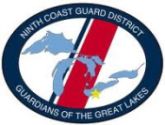
To the memory of those who never reached port,
the families they left behind,
and the survivors who told the tale.
The "Mataafa" Storm
Big storms seldom follow fast on the heels of another but that was not the case during the last week of November, 1905. November 23rd saw storm signals hoisted as heavy rain turned to snow, and driven by 60 mph winds, engulfed the region. Over the next two days the storm subsided and, on the 25th, vessels had again made their way out onto the lake.
Among them was the 525 foot Joseph G. Butler, Jr., leaving Lorain, Ohio on her maiden voyage. A voyage that was uneventful as she made her way upbound. The Butler cleared the Soo Locks on the morning of the 27th and, by afternoon, was heading across Whitefish Bay. The barometer plummeted and the Butler soon found herself in a blinding snowstorm. The seas, whipped by gale force winds, were so fierce that the propeller of the huge freighter was lifted out of the water between waves.
At Duluth the steamer R. W. England had fallen victim to the storm and was lying on a sand beach at Minnesota Point, four miles south of the harbor entrance. The schooner-barge Madeira had smashed into Gold Rock, north of where Split Rock lighthouse now stands, and was pounded to pieces. The Ira H. Owen, lost with her crew of 19, was downward bound with a cargo of barley and last seen about 40 miles off Outer Island.
The 429 foot Mataafa had left Duluth at 3:30 p.m. on the 27th, with Captain R. F. Humble in command and towing the barge James Nasmyth, but had turned back in the wee hours of the following morning. The Nasmyth was dropped when two miles out from the Duluth pierheads and threw both anchors. The entire city of Duluth was witness as the Mataafa made a run for the opening between the piers. Caught in cross-current between the following heavy seas and strong out-flowing currents, the Mataafa was laid sideways across the pierheads. With her engines dead the helpless Mataafa drifted astern and finally caught bottom 100 feet north of the pier where the savage beating continued, breaking her in two pieces. All initial rescue attempts proved futile and it wasn't until the next morning that fifteen survivors were rescued by the Duluth lifesaving crew. Nine men, including all of the engine crew, had perished.
Wrecks of the storm include:
Amboy, aground
Coralia, on the beach at Point Isabelle
Crescent City, against cliffs NE of Duluth
George Herbert, smashed to pieces at Two Island
George Spencer, aground near Tofte, MN
Ira H. Owen, sunk off Outer Island
Isaac Ellwood, aground at Duluth
Lafayette, stranded & broken up on Encampment Island
Madeira (barge of Edenborn) smashed to pieces on Gold Rock
Maia (barge of Coralia), on beach at Point Isabelle
Manila (barge in tow of Lafayette) aground at Encampment Island
Mataafa, aground at Duluth
Monkshaven, aground at Pie Island
Percy G. Walker, damaged, Two Harbors
R. W. England, aground at Duluth
W. E. Covey, stranded at Gull Island
Western Star, stranded on Fourteen Mile Point
William Edenborn, broken in two near Split Rock River
Vega, pounded to pieces near Fox Island


